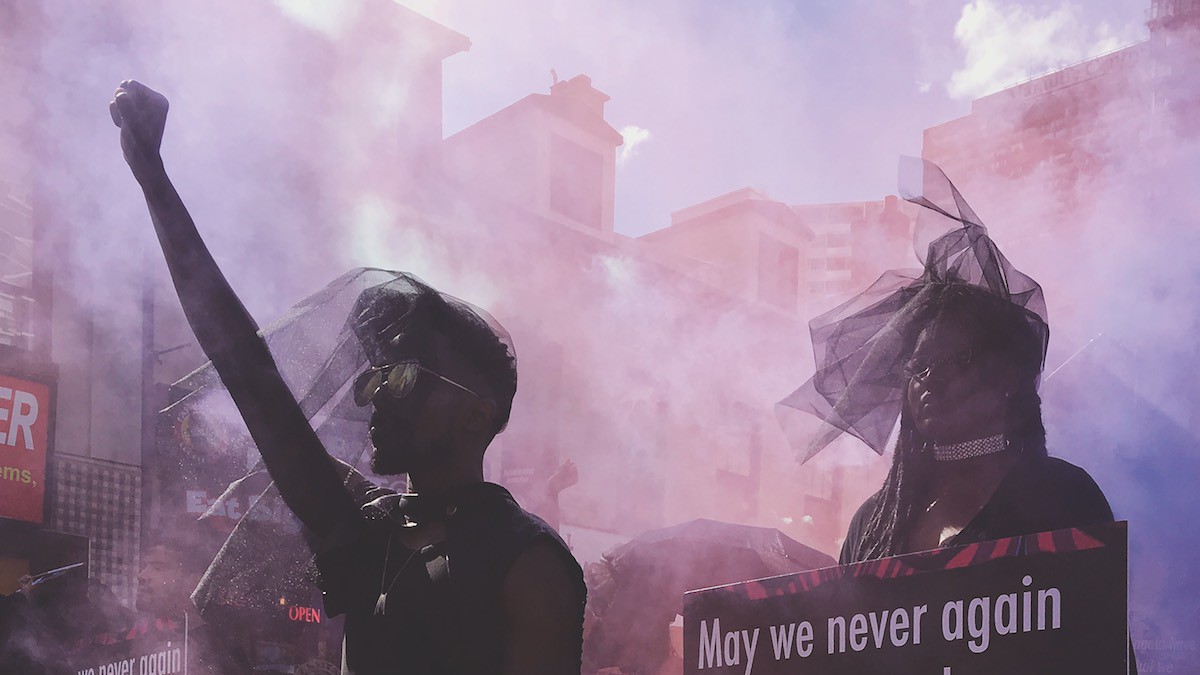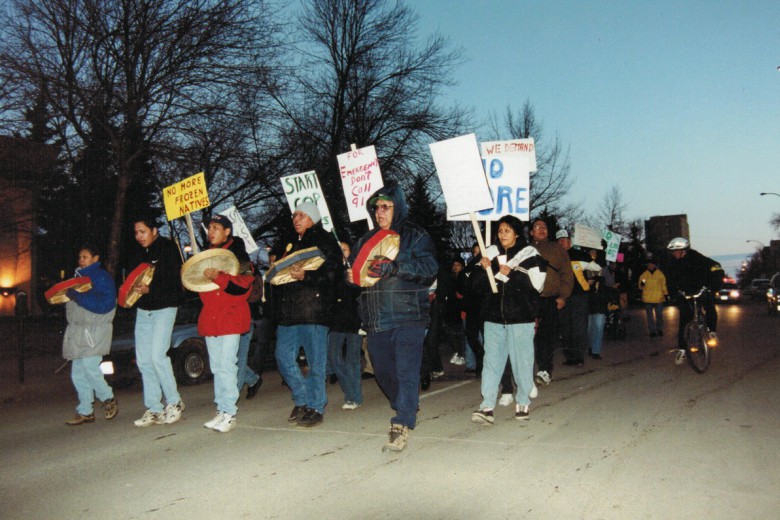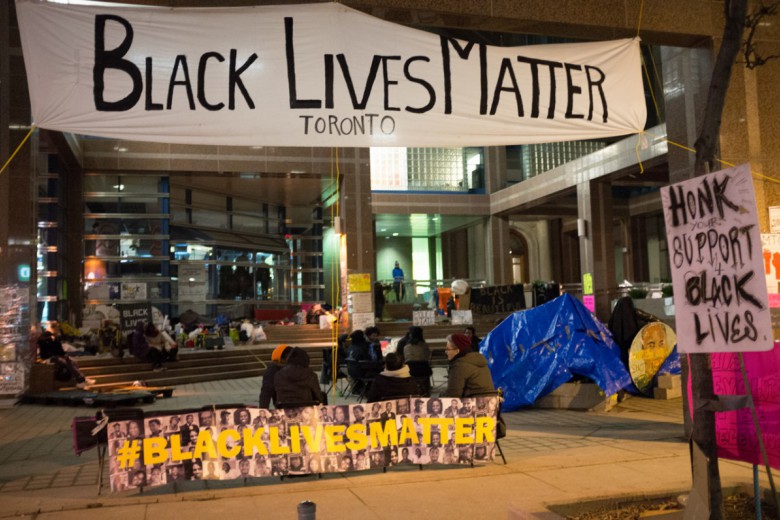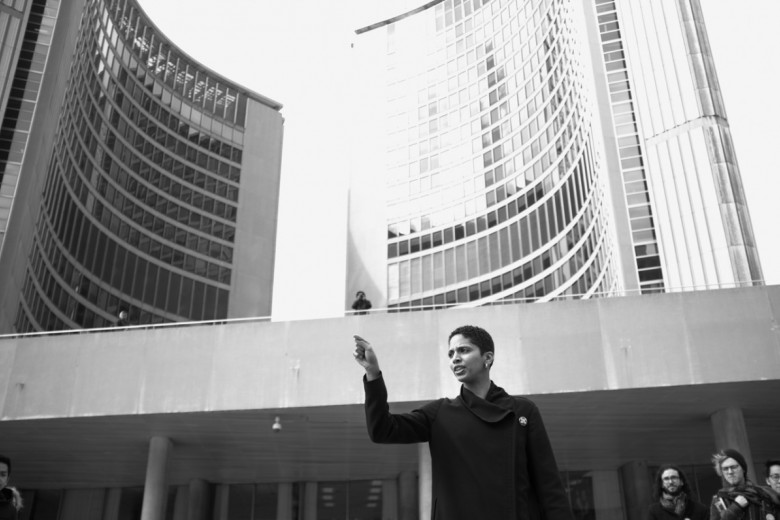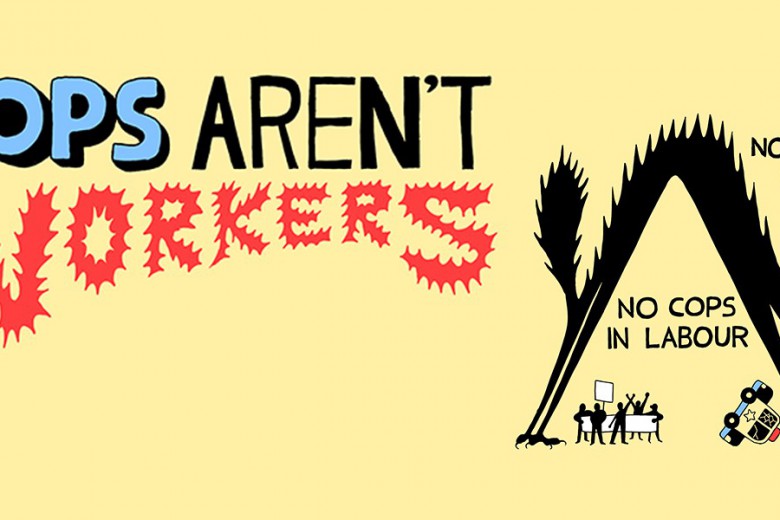The recent, high-profile acquittals of two white men, Gerald Stanley and Raymond Cormier, for the deaths of two Indigenous youth, Colten Boushie and Tina Fontaine, have caused a spike in public awareness of the failure of the Canadian justice system to protect Indigenous lives. In an effort to help Americans understand the importance of the acquittals, many have referred to Colten Boushie as the “Rodney King of Western Canada,” and described his death as “Canada’s Trayvon Martin moment.” These comparisons between the conditions of Black folks in the U.S. and Indigenous peoples in Canada are not new. In Nancy Macdonald’s 2016 Maclean’s article “Canada’s prisons are the ‘new residential schools,’” an unnamed doctor quips “there is a good reason they call Saskatchewan ‘Alabama North.’” Activists, academics, and journalists have increasingly adopted such comparisons to try to induce a sympathetic reaction from the white Canadian settler state and allies alike.
Though it’s usually well intentioned, equating Indigenous struggles with Black struggles is an inaccurate parallel – one that glosses over important differences in the ways that the Canadian and U.S. settler states operate, and erases the differences in the injustices that each group experiences.
In an effort to help Americans understand the importance of the acquittals, many have referred to Colten Boushie as the “Rodney King of Western Canada.”
Tina Fontaine spent months in the foster care system, followed by a run-in with police, and a documented visit to the hospital days before her body was pulled from the Red River. Black and Indigenous people clearly cannot look to the state and its sympathizers for protection or systemic change. Instead, our movements must be rooted in recognizing the differences between our experiences of oppression, and continuing to learn from and stand beside each other while building new, shared spaces to exist.
We are interested in opening a conversation about the complex and distinct histories of Black and Indigenous peoples in relation to land, policing, and gender. The two of us first met in 2017 when Phillip interviewed Nickita for a rabble.ca series on grassroots activism across the country. Nickita Longman is Saulteaux and a member of George Gordon First Nation in Treaty 4 Territory. Having spent the majority of her life in Regina, Saskatchewan, Nickita has mobilized herself on Indigenous issues on the Prairies. Phillip Dwight Morgan is a Toronto-based journalist and poet. He is a member of Education Not Incarceration, a team of youth, students, parents, educators, researchers, and community organizers in Toronto who have come together to address the school-to-prison pipeline.
Relationship to land
“I chuckle deeply to myself because they did not realize that body and homeland cannot be separated, that they are not distinct entities, that no matter where our bodies are we can feel our homelands in the night, can hear our ancestors murmuring and humming under our skin, can feel the lakes and rivers that we come from slowly trickle over rock.”
—Quill Christie-Peters, “Kwe becomes the moon, touches herself so she can feel full again,” GUTS Magazine
Nickita: There are few connections in the world as fierce as that of Indigeneity and relationship to land. As a Saulteaux woman growing up in an urban setting, I have physical distance from my reserve – but in another way, there is also a lot of closeness. Other Indigenous folks are immediately able to locate me when I tell them where I am from, and vice versa. This is a revolutionary sense of solidarity among Indigenous peoples that the government failed to extinguish while using divide-and-conquer tactics, implementing the pass system, and attempting mass genocide of our people. I get to carry the relationship to my reserve around with me in urban settings, but it all goes back to where we are from and how we are in relation to our ancestral lands.
I understand this as a major privilege. There are too many Indigenous folks who were forcibly removed from their homelands during the residential school era and the ’60s Scoop, or who suffered the loss of status due to the limitations within the Indian Act – each of which present overwhelming obstacles in regaining an understanding of what homelands they belong to.
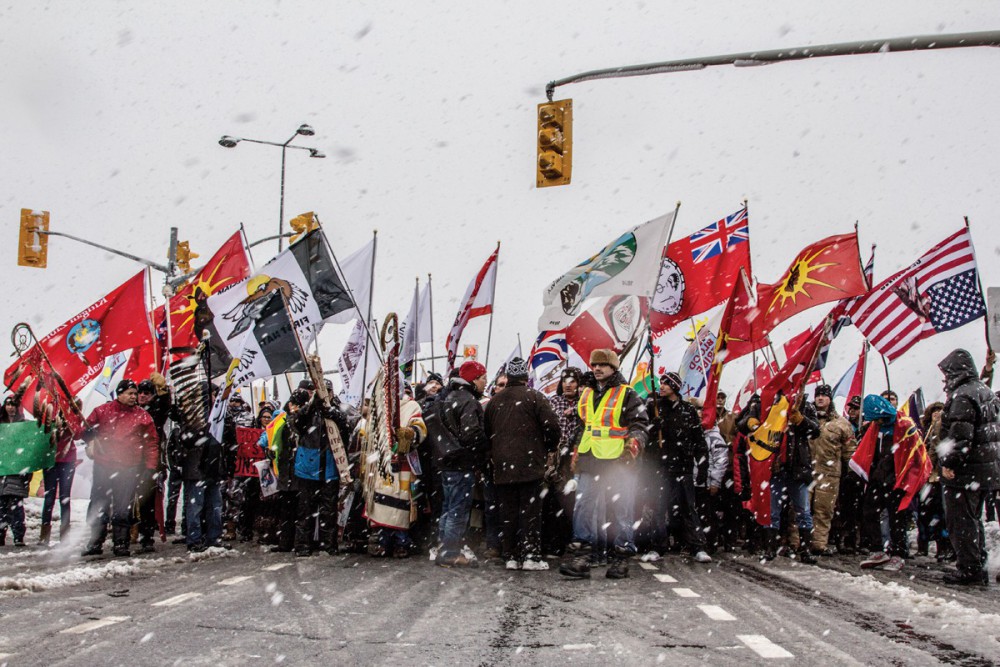
Phillip: The relationship between body and land that you describe is unfamiliar to me, as it’s tied to a different history, place, and context. I was born in Scarborough, Ontario, to Jamaican immigrants and gave little thought to land growing up. Despite all of the fanfare around diversity at my high school, I did not have any Indigenous friends growing up and my lessons in school were about white men who “founded” and “built” Canada.
Even as my friends and I began challenging the whole nation-building narrative, this skepticism didn’t affect our own relationships to the land. Even now, I know many Black folks who oppose police brutality, and housing and education discrimination, yet cling to the idea of owning a house as a strategy for achieving socio-economic stability. This vision of progress is, at its core, a more inclusive version of our existing hierarchy, essentially folding Black people into systems of domination and displacement rather than supporting Indigenous governance.
This vision essentially folds Black people into systems of domination and displacement, rather than supporting Indigenous governance.
I recently attended a teach-in at the University of Toronto where five Indigenous women spoke about Indigenous law and practice. Tracey Lindberg, a Cree author and academic, spoke about the importance of learning the protocols of any new territory she was entering; she said that this was to honour and acknowledge the people of that land. She also told everyone in the audience that they were, as of that moment, divested of their ignorance – they could no longer say that they were unaware of the importance of recognizing Indigenous law. I took this to heart. As many Indigenous activists call for settlers to repatriate land, I wonder: what does it mean for Black people to be materially and intellectually invested in the notion of property ownership, even if only as an abstract aspiration?
Policing
“Though there is a relationship, the racial logic of slavery and settler colonialism take different forms and are not reducible to one another; anti-Blackness and settler colonialism rest on somewhat different foundations.”
—Robyn Maynard, Policing Black Lives
Phillip: Black and Indigenous activists share a vested interest in fighting policing and, more broadly, state violence. Our communities are largely separate from each other and yet, all across the country, in rural and in urban communities, Black and Indigenous peoples are heavily surveilled, brutalized, and criminalized by police and authorities. Our communities are overrepresented in the child welfare system, in prisons, and in incidents when lethal force is used by police.
According to data from 2013, in Ontario, Black children or children with one Black parent constitute 42 per cent of the children in the care of the Children’s Aid Society. This is despite the fact that only eight per cent of the population under 18 years of age in Toronto is Black. In this same system, Indigenous children are much more likely to be investigated as possible victims of child abuse or neglect than white children – 130 per cent more likely, in fact.
Likewise, Indigenous adults make up five per cent of the Canadian population but 27 per cent of the in-custody federal offender population. For Black Canadians, these numbers are three per cent and nine per cent, respectively.
Our communities are overrepresented in the child welfare system, in prisons, and in incidents when lethal force is used by police.
Despite these similarities it is worth noting – as Eve Tuck, K. Wayne Yang, Pamela Palmater, and others have – that the logic of policing as it relates to Indigenous bodies is to erase their presence from the land, while with Black bodies it is a logic of diminishing our humanity or threatening what Robyn Maynard has called “Black personhood.”
In September 2016, I posted a video on Facebook in which I shared a few details of my life, things like enjoying rock climbing and carrot muffins, before discussing my fear of being killed by the police. I made the video after seeing footage of the shooting deaths of Keith Lamont Scott and Terence Crutcher in the United States; it was essentially an obituary on film. As people commented on the video, I realized that few people understood the personal experiences and context that I was bringing to the conversation around police shootings. Some people even commented that I was hyperbolizing my fear.
I see something similar happening in the wake of Colten Boushie’s and Tina Fontaine’s murders. As Indigenous people speak about these cases, I hear a depth of pain tied to a context and history that only Indigenous people can understand. I’ve heard Indigenous people recount collapsing to the ground when the verdicts were announced; their bodies simply revolted.
As I grapple with this question of Black–Indigenous solidarity, I am interested in exploring how we can gesture toward shared experiences of colonial violence without flattening our histories of enslavement, dehumanization, genocide, and erasure.
I’ve heard Indigenous people recount collapsing to the ground when the verdicts were announced; their bodies simply revolted.
Nickita: Policing looks uniquely different in rural communities on the Prairies. As agents of the illegitimate settler state, the RCMP have always had a tense relationship with Indigenous folks – particularly in rural settings. We witnessed this in real time with the brutal treatment of Debbie Baptiste, Colten Boushie’s mother, the day Colten was murdered on a rural farm not far from Red Pheasant First Nation. The RCMP’s callous treatment of Baptiste – and their negligent, half-baked investigation in its entirety – furthered the wedge between settlers and Indigenous folks, who are already expected to co-exist on stolen lands after many decades of attempted cultural genocide. It is implied that Indigenous people should succumb to the colonial construct of state and reserve lines (despite the eradication of the pass system), and accept that it is not always safe for us to move beyond those borders.
Because of the open antagonism of white settlers, many Indigenous people I know no longer feel safe on rural roads. What is most unsettling is we have been intimidated out of the freedom of accessing these gravel roads between urban centres and towns to get to and from our own reserves without fear and intimidation. Where are we to feel safe? Who is protecting us?
In many ways, the police forces and the RCMP work to uphold the illusion of “peace” between white settlers and everyone else. It begs for friction, tension, and violence when the land they operate on was forcibly taken from Indigenous peoples to begin with. A recent CBC investigation revealed that of all the law enforcement agencies in Canada, the RCMP were responsible for the greatest number of deaths involving police, at 118 victims over the past 17 years.
Further, Indigenous women make up less than three per cent of the population, but comprise 38 per cent of the women in federal prison. That number has risen by 109 per cent since 2001. Things are not improving. Brown and Black cis, heterosexual men are placed at the forefront when it comes to discussions of police brutality. We need to begin naming police violence against our women and gender nonconforming Black and Indigenous bodies – and that can begin with dismantling patriarchy in our own circles.
Gender
“We should not have to work so hard to overcome barriers imposed by people who were supposed to share these lands with us, as guests and eventually as kin. Nonetheless, to exist as an Indigenous woman or two-spirited person is an inherently political act. Simply resisting our erasure is part of our work.”
—Chelsea Vowel, “Indigenous women and two-spirited people: Our work is decolonization!” GUTS Magazine
Phillip: When it comes to stories about anti-Black racism in the news, my experience is that cisgender, heterosexual Black men such as myself are overrepresented in the discussion. This obscures the impact of anti-Black racism experienced by all other members of our Black communities.
Firstly, Black men – myself included – must learn to step back sometimes, showing the humility and integrity to admit when we are not in the best position to speak about certain issues. Secondly, we must begin strategically using the visibility and access we have to challenge the compounded oppressions that Black women and non-binary folks face.
I’ve witnessed Black men interrupting Black women to tell them that they should not be talking about carding because they’re not the ones getting harassed on the streets. This is patently false and certainly counterproductive.
Ultimately, our experiences of trauma and oppression do not amount to a disinvestment from patriarchy. This is something that I am recognizing in my own life and working on; it is difficult and necessary work within our communities.
When it comes to stories about anti-Black racism in the news, my experience is that cisgender, heterosexual Black men such as myself are overrepresented in the discussion.
The problem that I’m describing within Black communities also exists between Black and Indigenous communities, with each often remaining silent about the other’s oppressions. Instances of violence within and between our communities often go unchecked, as there is a really difficult calculation involved in holding people accountable while also acknowledging their trauma and violence. We need to begin addressing the misogyny, anti-Blackness, and anti-Indigeneity within and between our communities. This does not happen alongside dismantling settler colonialism but is, instead, part of the process.
Nickita: As a cisgender Indigenous woman with an opinion on and experience with oppression, I often find myself labelled as ‘intimidating’ or ‘unapproachable’ by white folks. I exist at the intersection of expectations of femininity – that I should be a warm welcome mat – and Indigeneity – that I should be assimilated and well adjusted to living under colonialism. It is a debilitating double standard foisted on brilliant Indigenous and Black women when sharing their opinions and experiences.
Patriarchy and misogyny know no bounds. They have crept their way into Indigenous lived experience, and more often than not, uphold our men in positions that leave our women, our two-spirit and LGBTQ (2SLGBTQ) folks underfoot. It is no surprise that our views and expressions are seen as second, third, or fourth rate in our own circles, especially when misogyny is compounded with the colonial nature of institutions like academia, law, and politics.
We need to acknowledge that men of colour can be our peers and our oppressors at the same time, and that holding them accountable is not violence, but rather an act toward justice and care.
What complicates things further is when women of colour call out or call in men of colour for their problematic behaviour. Ideally, accountability happens within our own cultures, although there are plenty of instances when it is necessary to fall outside of these lines. But when women of colour call out men in their communities, it’s often dismissed as “lateral violence” – violence that’s wrongly directed toward peers, rather than oppressors. And while lateral violence does exist, these accusations can also be weaponized to silence women and 2SLGBTQ folks seeking accountability in spaces where patriarchy and misogyny run rampant. We need to acknowledge that men of colour can be our peers and our oppressors at the same time, and that holding them accountable is not violence, but rather an act toward justice and care.
Recently, I helped write and publish an open letter alongside Indigenous women and two-spirit people who carry knowledge of physical abuse from an Indigenous man. Some of the harshest criticisms of the letter came from other Indigenous women. Sometimes we become so thoroughly conditioned by patriarchy that we come to its defence despite it being one of the most destructive weapons introduced by colonizers. It can only be dismantled by peeling back the layers of our own histories and addressing the ways our communities have been infiltrated by patriarchy.
These same tactics of peeling back our own histories also need to be applied to anti-Blackness in Indigenous communities. This can leave many people feeling vulnerable in the process, because these colonial histories have held us in place for so long. However, serious change and a commitment to solidarity to one another has rarely come out of staying comfortable.


